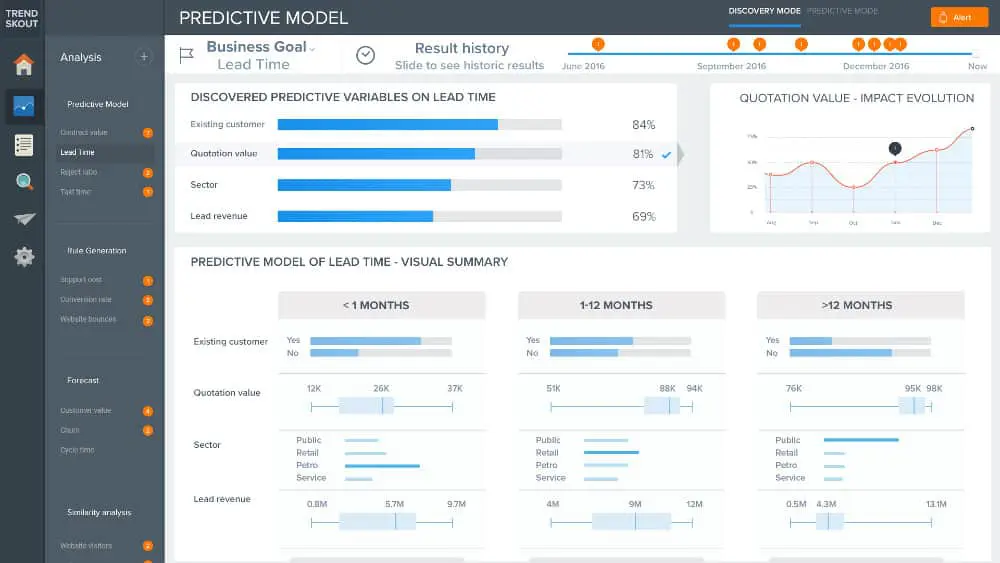Both Artificial Intelligence (AI) and Business Intelligence (BI) are often misused or even confused with one another. What exactly are the differences between AI and BI, what are their respective boundaries and where do both technologies overlap? And why are organizations increasingly using AI and BI together to improve their decision-making and their competitiveness? Let’s dive into the matter.
Reporting vs prediction
The terms BI and AI are often used interchangeably in a business context to describe tools that derive data-driven insight for decision-making purposes. While this definition is generally true for both technologies, it quickly becomes apparent that AI and BI are quite different indeed – both in theory and in practice. Summed up in one sentence: BI delivers comprehensible insight into past performance, while AI also predicts future trends and the most efficient actions.
AI in a nutshell
Artificial Intelligence or AI is a broad term for intelligent computer systems that mimic human-like thinking and learning. Artificial intelligence learns from past experiences and tries to simulate our human intuition and judgement. Problem-solving, continuous independent learning and situational decision-making are key to AI.
Artificial intelligence in organizations isn’t merely aimed at analyzing and interpreting large amounts of data, but also at acting upon the resulting findings and understandings. AI is capable of connecting the dots and makes predictions for its independent decision-making process. This helps businesses to deliver tangible results. Sales teams can concentrate their efforts on high-potential leads, while process operators are assisted in the downtime and maintenance estimates of their machinery.

BI makes the past accessible, while AI predicts the future.
BI explained
Business intelligence is used to collect and present data in a coherent, clear and comprehensible way, providing businesses with a clear picture of otherwise murky data. BI converts bulk data into readable reports. BI itself does not interpret data, but instead focuses on providing an understandable representation of data. Finding relevant insights and possible follow-up actions are the responsibility of the person reading the reports. For example, BI can generate a neat overview of sales leads, but is unable to predict which leads should be contacted first to maximize sales opportunities.
Overview
Below is a summary table of the concrete differences between artificial intelligence and business intelligence:
| BI | AI | |
|---|---|---|
| Concept | Collecting and presenting data in a simple, readable way. | Mimicking human intelligence and behaviour to support organizations with data-driven decision-making. |
| Focus | Answering questions about past performance. | Making predictions about the future based on data from the past. |
| Techniques used | Traditional statistical approaches and large amounts of spreadsheet-based data. |
Advanced Machine Learning and Deep Learning algorithms. |
| How it helps businesses | Data visualization and comprehensive overviews of historical data. | Predictions about customers, competitive positions and market changes, in addition to added intelligence in machines (e.g. for image recognition). |
| Key terms | Reporting, data warehousing, matrices, dashboards. | Predictive analysis, forecasting, natural language processing (NLP), image recognition. |
How BI and AI are better together
Judged on their individual merits, both AI and BI provide plenty of business value. Nevertheless, both technologies can also be deployed side-by-side for even better results. Combined BI and AI are the perfect recipe for delivering analytical solutions in any business context. First, BI gets to work by analyzing historical data. Next, AI predicts future actions based on the available information. The best of both worlds.
In practical terms, BI provides comprehensive reports, while AI makes predictions and recommends actions
This AI-enabled BI can dig deep into complex problems and uncover crucial insights into data that had previously been left uncovered or unexplored. When used together, they can automatically review vast quantities of data and alert decision-makers on interesting events and tendencies. Additionally, AI-powered BI platforms can free up time for analysts and enable them to focus on more effective data analysis. This way, decision-makers can both react and anticipate. By combining BI with the best capabilities of AI, companies have the opportunity to analyze data even more efficiently, gain actionable insights and anticipate the future. That is exactly where the added value lies.
Would you like to apply AI yourself? If so, we as AI companies will be happy to assist you. Contact one of our employees for more information.

